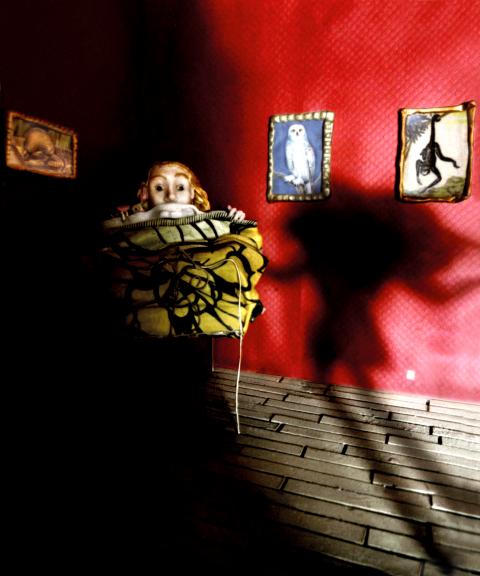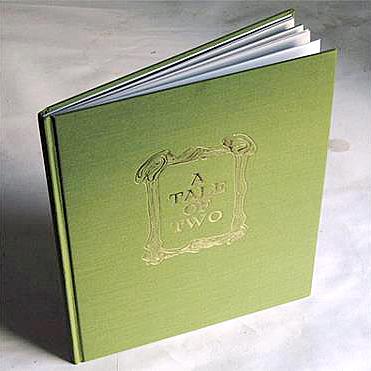Written by Canadian artist Michelle Wilson, A Tale of Two is a picture book about a pair of feuding siblings and the strange, subterranean world they get sucked into. But A Tale of Two is not your typical children’s fantasy. Illustrated with vividly-detailed tableaus Wilson built and photographed in her Kaohsiung apartment, A Tale of Two was created to contain layers of meanings that she hopes parents and kids will find equally engaging.
Installations will be on view at the Dog Pig Art Cafe (豆皮文藝咖啡館) in Kaohsiung starting on Tuesday. Visitors to the book’s Sept. 22 launch at the same venue have the chance to become fully immersed into the world Wilson created. The triple feature will include an interactive installation based on illustrations from A Tale of Two, screenings of vintage silent films and music performances by members of Squids, Loose Lion, The Apes Have Landed and The Blue Truckers. On Sept. 23, Wilson will host a reading for parents and children from 3:30pm to 5pm, during which attendees will be invited to interact with her artwork.
Wilson based the book on her childhood. “I started thinking of this idea of taking stories from what I did to my sisters when we were young, trying to scare them, trying to manipulate them with really horrifying stories,” she says.

Photo courtesy of Michelle Wilson
Fantasy films from the 1980s and 1990s, like Goonies, The Neverending Story and The Princess Bride also inspired the atmosphere of A Tale of Two.
“There is that tiny element of reality, but then there is this entrance into a fantasy world that somehow kids just stumble upon,” says Wilson.
A Tale of Two revolves around two sisters, Big Sis and Lil Sis, who live alone. As a part of an elaborate prank, Big Sis arranges for a giant black bat to fly out of a birthday cake she baked for her younger sibling.

Photo courtesy of Michelle Wilson
“The younger sister uses her birthday wish to say ‘I wish all that stuff you threaten me with would happen and you would know how it feels to be me,’” says Wilson. Her childish wish for revenge is unexpectedly granted and the two are pulled into an underground world filled with menacing monsters and mysterious caverns.
Visitors to the book’s launch event can immerse themselves into A Tale of Two through tented light boxes inspired by zoetropes, a spinning device that creates the visual illusion of movement with slots and a succession of images.
“One minute you are in a very real space and the next minute you just have to press your eyes up to the viewfinder and you are isolated in this fantasy world,” says Wilson. Her partner, Angus Cruikshank, composed music to go with each of the light boxes.
Also on view will be vintage silent films that Wilson edited down from their original playing times to 15 minutes each. They include horror classics like The Phantom of the Opera and Dr. Jekyll and Mr. Hyde, as well as a hand-tinted Georges Melies A Trip to the Moon.
Wilson wants the event to appeal to both the Taiwanese and expat communities. A Tale of Two has been published in English and Chinese, Cruikshank’s music has no lyrics and Wilson has invited students from English-language schools to participate in her Sept. 23 reading.
“You don’t have to be able to read the book, you will get the feel and vibe of it and that carries all the way through the narrative,” says Wilson. “The story itself, if you read it word for word as a book, is not intended for children. But anyone can reframe it in a way that is child friendly and kids respond to.”

In the March 9 edition of the Taipei Times a piece by Ninon Godefroy ran with the headine “The quiet, gentle rhythm of Taiwan.” It started with the line “Taiwan is a small, humble place. There is no Eiffel Tower, no pyramids — no singular attraction that draws the world’s attention.” I laughed out loud at that. This was out of no disrespect for the author or the piece, which made some interesting analogies and good points about how both Din Tai Fung’s and Taiwan Semiconductor Manufacturing Co’s (TSMC, 台積電) meticulous attention to detail and quality are not quite up to

April 21 to April 27 Hsieh Er’s (謝娥) political fortunes were rising fast after she got out of jail and joined the Chinese Nationalist Party (KMT) in December 1945. Not only did she hold key positions in various committees, she was elected the only woman on the Taipei City Council and headed to Nanjing in 1946 as the sole Taiwanese female representative to the National Constituent Assembly. With the support of first lady Soong May-ling (宋美齡), she started the Taipei Women’s Association and Taiwan Provincial Women’s Association, where she

Chinese Nationalist Party (KMT) Chairman Eric Chu (朱立倫) hatched a bold plan to charge forward and seize the initiative when he held a protest in front of the Taipei City Prosecutors’ Office. Though risky, because illegal, its success would help tackle at least six problems facing both himself and the KMT. What he did not see coming was Taipei Mayor Chiang Wan-an (將萬安) tripping him up out of the gate. In spite of Chu being the most consequential and successful KMT chairman since the early 2010s — arguably saving the party from financial ruin and restoring its electoral viability —

It is one of the more remarkable facts of Taiwan history that it was never occupied or claimed by any of the numerous kingdoms of southern China — Han or otherwise — that lay just across the water from it. None of their brilliant ministers ever discovered that Taiwan was a “core interest” of the state whose annexation was “inevitable.” As Paul Kua notes in an excellent monograph laying out how the Portuguese gave Taiwan the name “Formosa,” the first Europeans to express an interest in occupying Taiwan were the Spanish. Tonio Andrade in his seminal work, How Taiwan Became Chinese,